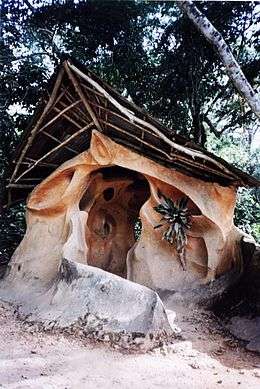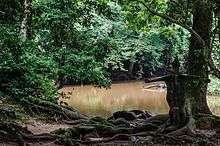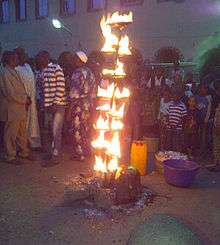Osun-Osogbo
Osun-Osogbo or Osun-Osogbo Sacred Grove is a sacred forest along the banks of the Osun river just outside the city of Osogbo, Osun State, Nigeria.
| UNESCO World Heritage Site | |
|---|---|
 | |
| Location | Osogbo, Nigeria |
| Criteria | Cultural: (ii), (iii), (vi) |
| Reference | 1118 |
| Inscription | 2005 (29th session) |
| Area | 75 ha (190 acres) |
| Buffer zone | 47 ha (120 acres) |
| Coordinates | 7°45′20″N 4°33′08″E |
 Location of Osun-Osogbo in Nigeria | |

The Osun-Osogbo Grove is among the last of the sacred forests which usually adjoined the edges of most Yoruba cities before extensive urbanization. In recognition of its global significance and its cultural value, the Sacred Grove was inscribed as a UNESCO World Heritage Site in 2005.[1]
The 1950s saw the desecration of the Osun-Osogbo Grove: shrines were neglected, priests abandoned the grove as customary responsibilities and sanctions weakened. Prohibited actions like fishing, hunting and felling of trees in the grove took place until an Austrian, Susanne Wenger, came and stopped the abuse going on in the grove.[2]
With the encouragement of the Ataoja and the support of the local people, "Wenger formed the New Sacred Art movement to challenge land speculators, repel poachers, protect shrines and begin the long process of bringing the sacred place back to life by establishing it, again, as the sacred heart of Osogbo".[3]
Osun-Osogbo Festival
Every year, the Osun-Osgogbo festival is celebrated in the month of August at the grove. Yearly, the festival attracts thousands of Osun worshippers, spectators and tourists from all walks of life.
For the people of Osogbo Land, August is a month of celebration, traditional cleansing of the city and cultural reunion of the people with their ancestors and founders of the Osogbo Kingdom.[4]
The Osun Osogbo festival is believed to have a history of more than 700 years. Historically, an ancestral occurrence led to the celebration of this festival. Once upon a time, a group of migrating people who were led by a great hunter called Olutimehin settled on the bank of Osun river, to save themselves from famine. At the river side, Osun the goddess appeared from the water in front of Olutimehin and requested him to lead people to a special place (present Osogbo town). The goddess promised to protect all the group and bring them prosperity in return for an annual sacrifice to her. The group accepted the proposition. Today the annual sacrifice to the Osun River Goddess is what is still celebrated as the Osun Osogbo Festival.[5]
The Osun-Osogbo Festival is a two-week-long programme. It starts with the traditional cleansing of the town called 'Iwopopo', which is followed in three days by the lighting of the 500-year-old sixteen-point lamp called 'Ina Olojumerindinlogun'.

Then comes the 'Iboriade', an assemblage of the crowns of the past ruler, Ataojas of Osogbo, for blessings. This event is led by the sitting Ataoja of Osogbo and the Arugba, Yeye Osun and a committee of priestesses.[6]
The concept of aesthetics in the Osun Osogbo festival
Aesthetics, according to general usage, is the perception of beauty. It is the appreciation of the beauty in all parts of life, but as a field of study it is mostly concerned with the arts. The aesthetics of the Osun Osogbo festival includes drumming, dancing, musical performing, wearing of elaborate costumes, speaking of the Yoruba language, recitation of praise poetry and so on.
These elements make the festival what it is, and adding pomp and colour to the proceedings. The festival is of immense benefit to the tourism sector of Nigeria. It enables the community to sell its culture to tourist coming from both within the country and all over the world.[7]
The Osun Osogbo festival also serves as a strong unifying factor in Osogboland, as irrespective of the different social, economic, religious and political convictions of the people, they all come together annually to celebrate the goddess.[7]
References
- Peter Probst. Osogbo and the Art of Heritage. Monuments. Deities, and Money. Bloomington: Indiana University Press, 2011.
- Peter Probst. "Modernism against Modernity. A Tribute to Susanne Wenger." Critical Interventions, Journal of African Art History and Visual Culture, 2009, No.3/4, 245-255. Peter Probst. "From Iconoclasm to Heritage. The Osogbo Art Movement and the Dynamics of Modernism in Nigeria." A Companion to Modern African Art. Edited by Gitti Salami and Monica Blackmun Visona (eds.) Malden, MA: Wiley-Blackwell, 2013, pp. 294-310.
- "Osun Osogbo: Carnival of culture in a sacred forest". The Punch - Nigeria's Most Widely Read Newspaper. Archived from the original on 3 June 2015. Retrieved 18 August 2015.
- "About - Osun Osogbo Festival". osunosogbofestival.com. Retrieved 18 August 2015.
- Agu, Zain (2018-08-07). "When will Osun Osogbo festival be this year?". Legit.ng - Nigeria news. Retrieved 2019-08-19.
- "Osun Osogbo Festival". logbaby.com. Retrieved 18 August 2015.
- "THE OSUN OSOGBO FESTIVAL (ITS FUNCTIONS AND AESTHETICS)". myproject.com.ng. Retrieved 11 November 2017.
External links
- Sacred Orisa Gardens of the West
- Osun Osogbo Sacred Grove- UNESCO
- Ijele: Art Ejournal of the African World
- Osun Osogbo, the film
- Lady from Osogbo, long feature film
- Oshunfilm
- Osun-Osogbo Sacred Grove
| Wikimedia Commons has media related to Temple of Osun-Osogbo. |